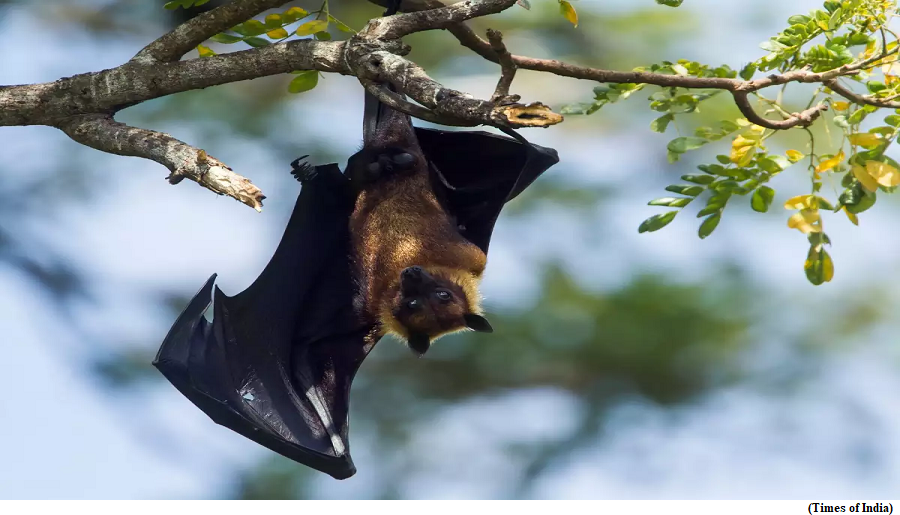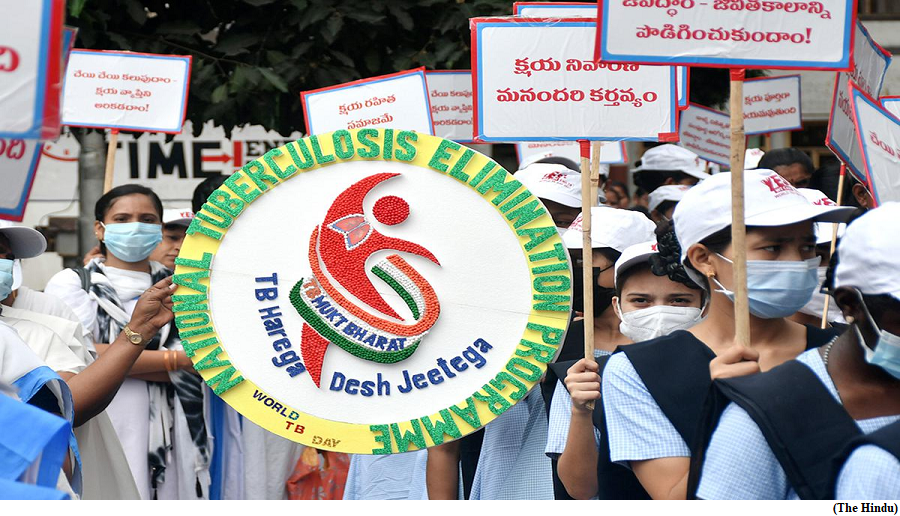Flying fox bats for vigilance while day-roosting, finds study (GS Paper 3, Environment)

Why in news?
- India’s largest species of bats, spends 7% of its day-roosting time being environmentally vigilant, a new study has said.
- The study focused on the environmental and social vigilance of one of two subspecies of the Indian flying fox.
Details:
- The nectar and fruit-eating flying fox (Pteropus giganteus) is generally considered a vermin as they raid orchards.
- It had a similar official status under the Schedule V of the Wildlife (Protection) Act of 1972 until it was put on the Schedule II list, entailing a higher degree of protection.
- It is a keystone species causing seed dispersals of many plants in tropical systems.
Keystone species:
- A keystone species is one that has a disproportionately large effect on its natural environment relative to its abundance, impacting many other organisms in an ecosystem and helping to determine the types and numbers of other species in an ecological community.
Vigilance behavior:
- The study describes vigilance behaviour as an individual scanning its surroundings for both competition and predation risk.
- Vigilance is social if an individual looks directly at another close-by individual approaching or likely to fight while vigilance of the environmental kind is gazing elsewhere, primarily watching for any signs of danger.
Key findings:
- Most bats forage at night and spend more than half of their lives roosting during the day in camps or colonies.
- Being external roosters, the flying fox is exposed to predators and disturbances apart from environmental indicators such as heat and light.
- It showed varying levels of vigilance according to roosting architecture. Across all positions, on average, they spent 7% of their roosting time being vigilant. Peripheral bats on a roosting tree showed a significant increase in environmental vigilance compared to the core, thus confirming the edge effect hypothesis.
- The flying foxes studied spent 82% of their roosting time sleeping but remain alert to their surroundings. Dependence on auditory perception gives the added advantage of not sacrificing sleep entirely.
Predators:
- The predators found in the area studied included jungle cats, golden jackals, common palm civets (found to use the roosting trees at night), crested serpent eagles, black kites, spotted owlets, collared scops owls, and barn owls.
- The biggest threat to the flying fox is from humans.
- Hunting for meat and medicine and probable threats like the felling of roost trees have contributed to the dramatic decrease in the population of the species.
Govt. planning law on protection of Indian manuscripts
(GS Paper 1, Culture)
Why in news?
- The government is planning to introduce the National Manuscripts Bill, 2023.
- The primary aim of the Bill is to document and catalogue Indian heritage texts wherever they may be in India or abroad, maintain accurate and up-to-date information about them, and detail the conditions under which they may be consulted.

Why it matters?
- The Bakhshali manuscript, an ancient Indian mathematical text written on birch bark, is considered to be the earliest recorded example of the use of zero.
- The seminal text, dating back roughly to the third or fourth century AD, is in one of the Bodleian Libraries of the University of Oxford.
- Many other Indian manuscripts lie in libraries across the globe or are with private collectors, both in India and abroad.
National Manuscripts Authority:
- The Bill envisages setting up a 10-member National Manuscripts Authority (NMA).
- While the Culture Minister will be the Chairperson of this body, the members will include the Secretaries of Culture, Finance and Education, the Vice-Chancellor of Central Sanskrit University, special invitees representing the States, and private agencies.
Functions & powers of NMA:
- The NMA will have the powers of a civil court to regulate the allocation of access to manuscripts and will also have an investigation wing for the purpose of conducting an inquiry into thefts and desecration of texts. It will also ensure that the manuscripts are not lost by damage or theft.
- It can collaborate with universities and other educational institutions or agencies to provide fellowships and scholarships for study of manuscripts.
- The NMA will also prepare a dedicated digital portal for indexing, cataloguing, uploading, and downloading copies of manuscripts.
- It will be vested with the right to take over a manuscript from a private owner based on the uniqueness and the importance of the content. The sum to be paid will be fixed by an expert committee.
What is Manuscript?
- Manuscripts are written on materials such as palm leaf, paper, cloth, and bark on themes ranging from history and religion to literature, astrology, and agricultural practice.
- While 75% of the existing manuscripts are in Sanskrit, 25% are in regional languages.
- India possesses an estimated 10 million manuscripts in 80 ancient scripts such as Brahmi, Kushan, Gaudi, Lepcha, and Maithili.
Can improved nutrition help prevent TB?
(GS Paper 2, Health)
Why in news?
- According to recent reports, nutritional support has helped prevent both tuberculosis (TB) among household contacts and mortality among TB patients in a trial in Jharkhand.

Why it matters?
- In 2017, the World Health Organization had estimated that undernutrition is responsible for twice the number of TB cases than HIV globally.
- Any attempt to end/eliminate TB in India by 2025 will become possible only if undernutrition among people is addressed. As per conservative estimates, 40% of new TB cases annually in India are due to undernutrition.
What are the key achievements of the trial?
- A large field-based trial was undertaken between August 2019 and August 2022 in four districts of Jharkhand.
- The RATIONS (Reducing Activation of Tuberculosis by Improvement of Nutritional Status) trial enrolled 2,800 people with pulmonary TB disease and 10,345 household contacts of TB patients.
- While all the TB patients received nutritional support, household contacts were randomly assigned to receive either nutritional support or usual diet alone.
- Among the household contacts, nutritional support led to a 39%-48% reduction in TB disease in the intervention group compared with the control arm.
- In the study that lasted for six months, 122 people in the control group developed TB whereas the intervention arm had only 96 TB cases.
- There was a 39% reduction in TB incidence while there was 48% reduction in pulmonary TB.
- The 39%-48% reduction in TB disease in the household contact intervention arm was after adjusting for confounding factors such as TB preventive treatment to children below five years, diabetes, smoking, and alcohol use.
What was the nutritional support provided?
- Each adult household contact in the intervention arm received 5 kg of rice, 1.5 kg of split pigeon peas (tur dal), and micronutrient pills every month for six months.
- Each child (below 10 years) household contact received 50% of the adult nutrition support. Those in the control arm did not get any nutritional supplementation.
- For TB patients, monthly nutritional support included 5 kg of rice, 1.5 kg of milk powder, 3 kg of roasted chickpea flour, 500 ml of oil, and micronutrient pills for a period of six months for people with drug-susceptible TB, and 12 months for people with MDR-TB.
What effect does undernutrition have?
- Many new cases of TB are attributable to five risk factors: undernourishment, HIV infection, alcohol use disorders, smoking (especially among men) and diabetes.
- In TB-endemic countries such as India, undernutrition is the most widely prevalent risk factor, accounting for the “highest population attributable risk for TB in India”. It is also responsible for increased TB disease severity, higher mortality and poor treatment outcomes.
- A study in India found that severe undernutrition at diagnosis was associated with a two-fold higher risk of death. For each unit reduction in BMI, the risk of TB increases by about 14%.
- Undernourished patients also tend to have poor bioavailability of drugs such as rifampicin, leading to treatment failure and development of multidrug resistance.
How do schemes like Nikshay Poshan Yojana and Ni-kshay Mitra help?
- Nikshay Poshan Yojana is a direct benefit transfer (DBT) scheme for nutritional support to TB patients.
- It was launched in 2018. All notified TB cases are provided with a financial incentive of ₹500 per month.




